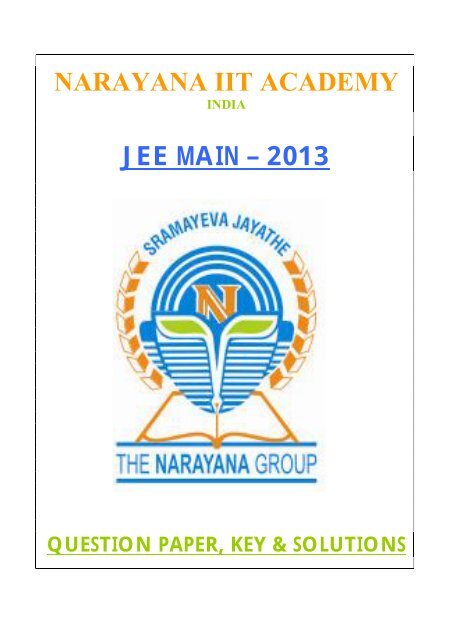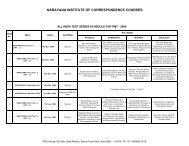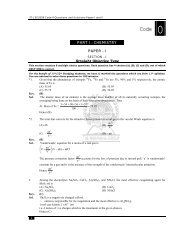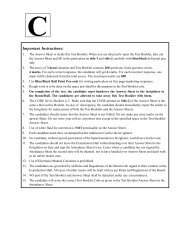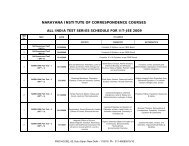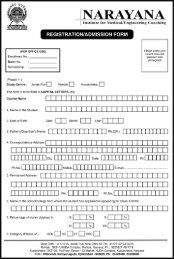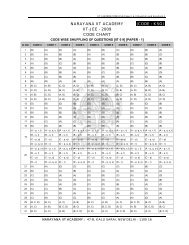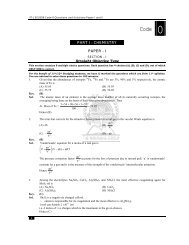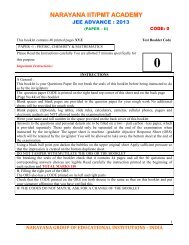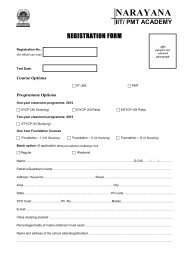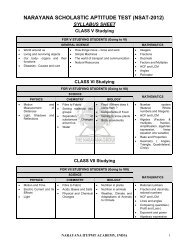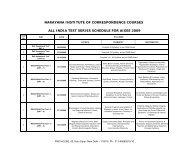NARAYANA IIT ACADEMY JEE MAIN â 2013 - Narayana Group
NARAYANA IIT ACADEMY JEE MAIN â 2013 - Narayana Group
NARAYANA IIT ACADEMY JEE MAIN â 2013 - Narayana Group
You also want an ePaper? Increase the reach of your titles
YUMPU automatically turns print PDFs into web optimized ePapers that Google loves.
<strong>NARAYANA</strong> <strong>IIT</strong> <strong>ACADEMY</strong><br />
INDIA<br />
<strong>JEE</strong> <strong>MAIN</strong> – <strong>2013</strong><br />
QUESTION PAPER, KEY & SOLUTIONS
Important Instructions :<br />
Time : 3 hr. CODE : P Maximum Marks – 360.<br />
1. Immediately fill in the particulars on this page of the Test Booklet with Blue/Black Ball<br />
point Pen. Use of pencil is strictly prohibited.<br />
2. The Answer Sheet is kept inside this Test Booklet. When you are directed to open the Test<br />
Booklet, take out the Answer Sheet and fill in the particulars carefully.<br />
3. The test is of 3 hours duration.<br />
4. The test Booklet consists of 90 questions. The maximum marks are 360.<br />
5. There are three parts in the questions paper A, B, C consisting of Physics, Chemistry and<br />
mathematics having 30 questions in each part of equation weightage. Each question is<br />
allotted 4 (four) marks for correct response.<br />
6. Candidates will be awarded marks as stated above in instruction No. 5 correct response of<br />
each question 1/4 (one fourth) marks will be deducted for indicating incorrect response of<br />
each questions. No deduction from the total score will be made if no response is indicated<br />
for an item in the answer sheet.<br />
7. There is only one correct response for each question. Filling up more than one response in<br />
any question will be treated as wrong response and marks for wrong response will be<br />
deducted accordingly as per instruction 6 above.<br />
8. Use Blue/ Black Ball Point Pen only for writing particulars/marking responses on Side -1<br />
and Side – 2 of the Answer Sheet. Use of Pencil is strictly prohibited.<br />
9. No candidate is allowed to carry any textual material, printed or written, bits of papers<br />
pager, mobile phone, any electronic device, etc. except the Admit Card inside the<br />
examination hall/room.<br />
10. Rough work is to be done on the space provided for this purpose in the Test Booklet Only.<br />
This space is given at the bottom of each page and in 3 page (Pages 21-23) at the end of the<br />
booklet.<br />
11. On completion of the test, the candidate must hand over the Answer Sheet to the<br />
Invigilator on duty in the Room/Hall. However, the candidates are allowed to take away<br />
this Test Booklet with them.<br />
12. The CODE for this Booklet is P. Make sure that the CODE printed on Side – 2 of the<br />
Answer Sheet is the same as that on this booklet. In case of discrepancy, the candidate<br />
should immediately report the matter to the invigilator for replacement of both the Test<br />
Booklet and the Answer Sheet.<br />
13. Do not fold or make any stray marks on the Answer Sheet.<br />
<strong>NARAYANA</strong> <strong>IIT</strong> <strong>ACADEMY</strong> <strong>JEE</strong> <strong>MAIN</strong> – <strong>2013</strong>
PHYSICS<br />
1. A uniform cylinder of length L and mass M having cross – sectional area A is suspended,<br />
with its length vertical, from a fixed point by a massless spring, such that it is half submerged<br />
in a liquid of density at equilibrium position. The extension x 0 of the spring when it is in<br />
equilibrium is :<br />
(1) Mg<br />
Mg LA<br />
Mg LA<br />
Mg LA<br />
<br />
(2) 1<br />
(3) 1<br />
(4) 1<br />
<br />
k<br />
k M k 2M k M <br />
(Here k is spring constant)<br />
Key. 3<br />
L<br />
Sol. kx Ag Mg<br />
0<br />
2<br />
L<br />
kx0<br />
Mg Ag<br />
2<br />
LA<br />
<br />
Mg<br />
<br />
1<br />
2M <br />
<br />
kx 0<br />
F<br />
B<br />
F<br />
B<br />
= L Ag<br />
2<br />
Mg<br />
2. A metallic rod of length ‘1’ is tied to a string of length 2l and made to rotate with angular<br />
speed on a horizontal table with one end of the string fixed. If there is a vertical magnetic<br />
field ‘B’ in the region, the e.m.f. induced across the ends of the rod is :<br />
2l<br />
l<br />
(1)<br />
Key. 4<br />
2Bl<br />
2<br />
2<br />
(2)<br />
3Bl<br />
2<br />
2<br />
(3)<br />
4Bl<br />
2<br />
2<br />
(4)<br />
5Bl<br />
2<br />
2<br />
<strong>NARAYANA</strong> <strong>IIT</strong> <strong>ACADEMY</strong> <strong>JEE</strong> <strong>MAIN</strong> – <strong>2013</strong>
Sol.<br />
1 2<br />
<br />
AC B (3 )<br />
2<br />
1 2<br />
AB<br />
B (2 )<br />
2<br />
5B<br />
<br />
BC AC AB<br />
2<br />
2<br />
A B C<br />
2l<br />
l<br />
3. This question has Statement I and Statement II. Of the four choices given after the<br />
Statements, choose the one that best describes the two Statements.<br />
Statement – I : A point particle of mass m moving with speed v collides with stationary point<br />
particle of mass M. If the maximum energy loss possible is given as<br />
1 2<br />
m<br />
f m<br />
then f <br />
<br />
<br />
2 M m .<br />
Statement – II : Maximum energy loss occurs when the particles get stuck together as a<br />
result of the collision.<br />
(1) Statement – I is true, Statement – II is true, Statement – II is a correct explanation of<br />
Statement – I.<br />
(2) Statement – I is true, Statement – II is true, Statement – II is Not a correct explanation of<br />
Statement – I.<br />
(3) Statement – I is true, Statement-II is false.<br />
(4) Statement – I is false, Statement – II is true.<br />
Key. 4<br />
Sol. mV + M(0) = mV 1 + MV 2<br />
V V<br />
2 1<br />
e<br />
O<br />
<br />
2 1<br />
mV<br />
V V <br />
2 1<br />
m M<br />
1 2 1 2 1 2 <br />
Loss mV mV MV<br />
1 2<br />
2 <br />
<br />
2 2 <br />
<br />
2 2<br />
1 2 (m M) m V <br />
mV <br />
2<br />
2 2<br />
<br />
(m M)<br />
<br />
<br />
2<br />
MmV<br />
; So statement I is wrong.<br />
2<br />
2(m M)<br />
4. Let 0 denote the dimensional formula of the permittivity of vacuum. If M = mass, L =<br />
length, T = time and A = electric current, then :<br />
1 3 2<br />
1 3 4 2<br />
(1) [ ] [M L T A]<br />
(2) [ ] [M L T A ]<br />
0<br />
1 2 1 2<br />
1 2 1<br />
(3) [ ] [M L T A ]<br />
(4) [ ] [M L T A]<br />
0<br />
<strong>NARAYANA</strong> <strong>IIT</strong> <strong>ACADEMY</strong> <strong>JEE</strong> <strong>MAIN</strong> – <strong>2013</strong><br />
0<br />
0
Key. 2<br />
Sol. [ ] [M] [L] [T] [A]<br />
0<br />
M L A T<br />
a b c d<br />
[M] [L] [T] [A]<br />
1 3 2 4 a b c d<br />
5. A projectile is given an initial velocity of ˆ i 2j ˆ<br />
m/s, where<br />
î is along the ground and ĵ is<br />
along the vertical. If g = 10 m/s 2 , the equation of its trajectory is :<br />
(1) y = x – 5x 2 (2) y = 2x – 5x 2 (3) 4y = 2x – 5x 2 (4) 4y = 2x – 25x 2<br />
Key. 2<br />
Sol. x = (1) t<br />
1 2<br />
y 2t gt<br />
2<br />
2<br />
gx<br />
y 2x <br />
2<br />
6. The amplitude of a damped oscillator decreases to 0.9 times its original magnitude in 5s. In<br />
another 10s it will decrease to times its original magnitude, where equals :<br />
(1) 0.7 (2) 0.81 (3) 0.729 (4) 0.6<br />
Key. 3<br />
Sol.<br />
kt<br />
A A e <br />
0<br />
0<br />
A 1 A0<br />
ln kt t ln<br />
A k A<br />
1 10<br />
5 ln<br />
k 9<br />
…(1)<br />
1 1<br />
15 ln<br />
k <br />
….(2)<br />
3<br />
1 10<br />
<br />
<br />
9 <br />
3<br />
(0.9) 0.729<br />
7. Two capacitors C 1 and C 2 are charged to 120 V and 200 V respectively. It is found that by<br />
connecting them together the potential on each one can be made zero. Then<br />
(1) 5C1 3C2<br />
(2) 3C1 5C2<br />
(3) 3C1 5C2<br />
0 (4) 9C1 4C2<br />
Ans. (2)<br />
Sol.<br />
C1 120 200C2<br />
3C 5C<br />
1 2<br />
<strong>NARAYANA</strong> <strong>IIT</strong> <strong>ACADEMY</strong> <strong>JEE</strong> <strong>MAIN</strong> – <strong>2013</strong>
8. A sonometer wire of length 1.5 m is made of steel. The tension in it produces an elastic strain<br />
of 1%. What is the fundamental frequency of steel if density and elasticity of steel are 7.7 ×<br />
10 3 kg/m 3 and 2.2 × 10 11 N/m 2 respectively?<br />
(1) 188.5 Hz (2) 178.2 Hz (3) 200.5 Hz (4) 770 Hz<br />
Ans. (2)<br />
Sol. Stress = Y × strain<br />
11 1<br />
2.210<br />
<br />
100<br />
F<br />
9<br />
2.2 10<br />
A <br />
f<br />
f<br />
0<br />
v 1 F<br />
<br />
2l<br />
2l<br />
A<br />
1 2.210<br />
5<br />
1 20 10<br />
2 1.5 7.7 10 3 7<br />
0 3<br />
9<br />
1 2 3<br />
f0<br />
10<br />
3 7<br />
f0<br />
178.17<br />
Hz<br />
9. A circular loop of radius 0.3 cm lies parallel to a much bigger circular loop of radius 20 cm.<br />
The centre of the small loop is on the axis of the bigger loop. The distance between their<br />
centres is 15 cm. If a current of 2.0 A flows through the smaller loop, then the flux linked<br />
with bigger loop is<br />
11<br />
(1) 9.1 10 weber<br />
11<br />
(2) 6 10 weber<br />
11<br />
(3) 3.310 weber g<br />
9<br />
(4) 6.6<br />
10 weber<br />
Ans. (1)<br />
Sol.<br />
<br />
2<br />
0i r1<br />
3/2<br />
2 2<br />
1 1<br />
2 r r<br />
<br />
<br />
r<br />
2<br />
2<br />
<br />
Mi<br />
<br />
2 2<br />
0 r1 r2<br />
3/2<br />
2 2<br />
1 <br />
<br />
M <br />
2 r x<br />
Mi<br />
<br />
<br />
<br />
2 2<br />
0 r1 r2<br />
3/2<br />
2 2<br />
1 <br />
<br />
<br />
2 r x<br />
i<br />
<strong>NARAYANA</strong> <strong>IIT</strong> <strong>ACADEMY</strong> <strong>JEE</strong> <strong>MAIN</strong> – <strong>2013</strong>
2 2<br />
2 2<br />
3.14 2010 7<br />
0.310<br />
<br />
<br />
2 2<br />
2 2<br />
2<br />
<br />
<br />
2010 1510<br />
<br />
<br />
410 2<br />
3/2<br />
11<br />
9.1<br />
10<br />
<br />
10. Diameter of a plano-convex lens is 6 cm and thickness at the centre is 3 mm. If speed of light<br />
in material of lens is 2 × 10 8 m/s, the focal length of the lens is<br />
(1) 15 cm (2) 20 cm (3) 30 cm (4) 10 cm<br />
Ans. (3)<br />
2 2<br />
2<br />
Sol. R R 0.3 3<br />
R 15.15cm<br />
2 1 2 1<br />
<br />
v u R<br />
3 / 2 1 3 / 2 1<br />
<br />
v 15<br />
3 1<br />
<br />
2v 2 15<br />
V = 45 cm<br />
v 45<br />
f <br />
3 / 2<br />
f = 30 cm<br />
11. What is the minimum energy required to launch a satellite of mass m from the surface of a<br />
planet of mass M and radius R in a circular orbit at an altitude of 2R?<br />
(1) 5GmM<br />
(2) 2GmM (3) GmM (4) GmM<br />
6R<br />
3R<br />
2R<br />
3R<br />
Ans. (1)<br />
GMm GMm 5GMm<br />
Sol. E<br />
<br />
6R R R<br />
12. A diode detector is used to detect an amplitude modulated wave of 60% modulation by using<br />
a condenser of capacity 250 pico farad in parallel with a load resistance 100 kilo ohm. Find<br />
the maximum modulated frequency which could be detected by it.<br />
(1) 10.62 MHz (2) 10.62 kHz (3) 5.31 MHz (4) 5.31 kHz<br />
Ans. NO OPTION<br />
SOL. QUESTION AMBIGUITY<br />
<strong>NARAYANA</strong> <strong>IIT</strong> <strong>ACADEMY</strong> <strong>JEE</strong> <strong>MAIN</strong> – <strong>2013</strong>
13. A beam of unpolarised light of intensity I 0 is passed through a Polaroid A and then through<br />
another Polaroid B which is oriented so that its principal plane makes an angle of 45°<br />
relative to that of A. The intensity of the emergent light is:<br />
(1) I 0 (2) I 0 /2 (3) I 0 /2 (4) I 0 /8<br />
Ans. (3)<br />
Sol.<br />
I0<br />
I(1st polarisation)<br />
<br />
2<br />
I0 2 I0<br />
I(2nd polarisation)<br />
cos 45 <br />
2 4<br />
14. The supply voltage to a room is 120 V. The resistance of the lead wires is 6 . A 60 W bulb is<br />
already switched on. What is the decrease of voltage across the bulb, when a 240 W heater is<br />
switched on in parallel to the bulb?<br />
(1) Zero Volt (2) 2.9 Volt (3) 13.3 Volt (4) 10.04 Volt<br />
Ans. (4)<br />
Sol.<br />
2<br />
240<br />
R<br />
0<br />
= 6<br />
60W<br />
R 1<br />
=<br />
120<br />
60<br />
=240<br />
R<br />
0<br />
= 6<br />
S<br />
240 W<br />
R 2<br />
2<br />
120<br />
240<br />
=60<br />
60<br />
15.<br />
120 V<br />
When S is open<br />
120<br />
240<br />
Vbulb<br />
117.073<br />
246<br />
When S is closed<br />
2<br />
120<br />
Peq<br />
300W R<br />
eq<br />
<br />
300<br />
48 (Heater and Bulb)<br />
120<br />
48<br />
Vbulb<br />
106.66<br />
54<br />
V 10.4 V no option is correct<br />
The closest option is (4) only<br />
120 V<br />
15.<br />
2p 0<br />
p p 0<br />
v 0<br />
v<br />
2v 0<br />
<strong>NARAYANA</strong> <strong>IIT</strong> <strong>ACADEMY</strong> <strong>JEE</strong> <strong>MAIN</strong> – <strong>2013</strong>
The above p-v diagram represents the thermodynamic cycle of an engine, operating with an<br />
ideal monatomic gas. The amount of heat, extracted from the source in a single cycle is:<br />
13 <br />
11<br />
(1) p0v 0<br />
(2) p<br />
0 v<br />
0<br />
(3) p<br />
0 v<br />
0<br />
(4) 4p0v<br />
0<br />
2 <br />
2 <br />
Ans. (2)<br />
13<br />
Sol. Only positive q is to be considered hence q<br />
povo<br />
2<br />
16. A hoop of radius r and mass m rotating with an angular velocity <br />
0<br />
is placed on a rough<br />
horizontal surface. The initial velocity of the centre of the hoop is zero. What will be the<br />
velocity of the centre of the hoop when it ceases to slip?<br />
r0<br />
r0<br />
r0<br />
(1) (2) (3) (4) r<br />
0<br />
4<br />
3<br />
2<br />
Ans. (3)<br />
Sol. Applying conservation of angular momentum about point of contact<br />
I0 I<br />
MVcR<br />
0<br />
<br />
v0=0<br />
v c<br />
2 2 vc<br />
MR 0 MR MvcR<br />
R<br />
2<br />
MR 2MRv<br />
0 c<br />
initial final<br />
R0<br />
vc<br />
<br />
2<br />
17. An ideal gas enclosed in a vertical cylindrical container supports a freely moving piston of<br />
mass M. The piston and the cylinder have equal cross sectional area A. When the piston is in<br />
equilibrium, the volume of the gas is V 0 and its pressure is P 0 . The piston is slightly displaced<br />
from the equilibrium position and released. Assuming that the system is completely isolated<br />
from its currounding, the piston executes a simple harmonic motion with frequency:<br />
Ans. (3)<br />
1 AP0<br />
(1)<br />
2<br />
V M<br />
0<br />
1 V0MP<br />
0<br />
(2)<br />
2<br />
2<br />
A <br />
(3)<br />
2<br />
1 A P<br />
2<br />
MV<br />
0<br />
0<br />
1 MV0<br />
(4)<br />
2<br />
AP<br />
0<br />
A M<br />
P 0 ,V 0<br />
Sol.<br />
<strong>NARAYANA</strong> <strong>IIT</strong> <strong>ACADEMY</strong> <strong>JEE</strong> <strong>MAIN</strong> – <strong>2013</strong>
dV<br />
If displaced by x then Frestoring<br />
A.dP AB V<br />
2<br />
Ax<br />
2 BA x<br />
Frestoring<br />
A.B M x <br />
V0 V0<br />
2<br />
P0<br />
A x<br />
<br />
V<br />
0<br />
A P 1 A P<br />
2 <br />
MV 2 MV<br />
2 2<br />
0 0<br />
0 0<br />
18. If a piece of metal is heated to temperature and then allowed to cool in a room which is at<br />
temperature 0, the graph between the temperature T of the metal and time t will be closed<br />
to :<br />
T<br />
T<br />
T<br />
T<br />
1.<br />
2. 0<br />
3. 0<br />
4. 0<br />
0 t<br />
0 t<br />
0 t<br />
0 t<br />
Ans. (3)<br />
d 4 4<br />
Sol. As per Stefan’s Law <br />
0 which decrease with t<br />
dt<br />
19. This question has Statement – I and Statement – II. Of the four choices given after the<br />
Statements, choose the one that best describes the two Statements.<br />
Statement – I : Higher the range, greater is the resistance of ammeter.<br />
Statement – II : To increase the range of ammeter, additional shunt needs to be used across<br />
it.<br />
(1) Statement – I is true, Statement – II is true, Statement – II is the correct explanation of<br />
Statement – I<br />
(2) Statement – I is true, Statement – II is true, Statement – II is not the correct explanation<br />
of Statement – I<br />
(3) Statement – I is true, Statement – II is false<br />
(4) Statement – I is false, Statement – II is true<br />
Ans. (4)<br />
Range of the ammeter is given by<br />
R<br />
g <br />
I Ig<br />
1<br />
<br />
R <br />
and resistance of the ammeter is given by<br />
R R<br />
gR<br />
R R<br />
g<br />
Hence to have higher range, is the resistance of ammeter should be made smaller.<br />
0<br />
<strong>NARAYANA</strong> <strong>IIT</strong> <strong>ACADEMY</strong> <strong>JEE</strong> <strong>MAIN</strong> – <strong>2013</strong>
20. In an LCR circuit as shown below both switches are open initially. Now switch S 1 is closed, S 2<br />
kept open. (q is charge on the capacitor and RC is Capacitive time constant). Which of<br />
the following statement is correct?<br />
V<br />
R<br />
C<br />
S 1<br />
L<br />
(1) Work done by the battery is half of the energy dissipated in the resistor<br />
CV<br />
2<br />
<br />
1<br />
(2) At t , q (3) At t 2 , q CV(1 e ) (4) At t , q CV(1 e )<br />
2<br />
2<br />
Ans. (3)<br />
As during the charging<br />
t/<br />
<br />
q CV(1 e )<br />
Hence at t 2<br />
2<br />
q CV(1 e )<br />
21. Two coherent point sources S 1 and S 2 are separated by a small distance ‘d’ as shown. The<br />
fringes obtained on the screen will be<br />
S 2<br />
d<br />
S 1 S 2<br />
d<br />
O<br />
Screeen<br />
(1) points (2) straight lines (3) semi-circles (4) concentric circles<br />
Ans. (4)<br />
The waves reaching from S 1 and S 2 at any point on the screen which is equidistant from the<br />
central points O will have same path difference. So locus of such points will be concentric<br />
circles on the Screen.<br />
22. The magnetic field in a traveling electromagnetic wave has a peak value of 20 nT. The peak<br />
value of electric field strength is<br />
(1) 3 V/m (2) 6 V/m (3) 9 V/m (4) 12 V/m<br />
Ans. (2)<br />
Sol : As, E BC<br />
9 8<br />
Hence, E 2010 310 6 V / m<br />
<strong>NARAYANA</strong> <strong>IIT</strong> <strong>ACADEMY</strong> <strong>JEE</strong> <strong>MAIN</strong> – <strong>2013</strong>
23. The anode voltage of a photocell is kept fixed. The wavelength of the light falling on the<br />
cathode is gradually changed. The plate current I of the photocell varies as follows :<br />
I<br />
I<br />
(1)<br />
O<br />
(2)<br />
O<br />
I<br />
I<br />
(3)<br />
O<br />
(4)<br />
O<br />
Ans. (4)<br />
When is increased the cutoff value of current will stop.<br />
24. The I – V characteristic of an LED is<br />
(1)<br />
I<br />
I<br />
O<br />
Red<br />
Yellow<br />
Green<br />
Blue<br />
(R) (Y) (G) (B)<br />
V<br />
R<br />
(3)<br />
(4)<br />
Y<br />
G<br />
O<br />
V<br />
B<br />
Ans. (1)<br />
I<br />
I – V characteristic of an LED is similar to forward I – V characteristics of P – N junction<br />
diode and threshold voltage increases on decreasing the wavelengths.<br />
25. Assume that a drop of liquid evaporates by decrease in its surface energy, so that its<br />
temperature remains unchanged. What should be the minimum radius of the drop for this to<br />
be possible? The surface tension is T, density of liquid is and L is its latent heat of<br />
vaporization.<br />
(1) L/T (2) T / L (3) T/L (4) 2T/L<br />
Key: 4<br />
Sol: (4)<br />
Let the radius of drop is x and ‘dx’ thickness of drop evaporates. Change is Area = A = 4x 2<br />
– 4(x – dx) 2<br />
<strong>NARAYANA</strong> <strong>IIT</strong> <strong>ACADEMY</strong> <strong>JEE</strong> <strong>MAIN</strong> – <strong>2013</strong><br />
(2)<br />
I<br />
B<br />
G<br />
Y<br />
R<br />
O<br />
V<br />
V<br />
O
2<br />
<br />
= 4x 2 dx <br />
1 1 8xdx<br />
<br />
x <br />
So energy released = T. 8xdx<br />
Volume of liquid evaporates = 4x 2 dx<br />
So, T . 8xdx = . 4x 2 2T<br />
dx . L x L<br />
26. In a hydrogen like atom electron makes transition from an energy level with quantum<br />
number n to another with quantum number (n – 1). If n > > 1, the frequency of radiation<br />
emitted is proportional to<br />
(1) 1 1<br />
1<br />
1<br />
(2) (3) (4)<br />
2<br />
3/ 2<br />
3<br />
n<br />
n<br />
n<br />
n<br />
Key : 4<br />
Sol: (4)<br />
2 1 1 <br />
RCZ <br />
2 2 <br />
(n 1) n <br />
<br />
2 <br />
2<br />
2<br />
= RCZ 1 RCZ 1 <br />
<br />
<br />
1<br />
1 1<br />
2 2<br />
2 <br />
n <br />
<br />
1 n n <br />
1<br />
<br />
<br />
n<br />
<br />
<br />
2 2<br />
RCZ 2 2RCZ 1<br />
= 1 1<br />
2 <br />
3 3<br />
n n n n<br />
27. The graph between angle of deviation () and angle of incidence (i) for a triangular prism is<br />
represented by<br />
d<br />
d<br />
O<br />
(1) i<br />
d<br />
O<br />
(2) i<br />
d<br />
O<br />
(3) i<br />
O<br />
(4) i<br />
Key : 3<br />
Sol: (3)<br />
= i + e – A, when i = e, is minimum.<br />
28. Two charges, each equal to q, are kept at x = – a and x = a on the x-axis. A particle of mass<br />
m and charge q<br />
0<br />
q is placed at the origin. If charge q 0 is given a small displacement (y < <<br />
2<br />
a) along the y – axis, the net force acting on the particle is proportional to<br />
<strong>NARAYANA</strong> <strong>IIT</strong> <strong>ACADEMY</strong> <strong>JEE</strong> <strong>MAIN</strong> – <strong>2013</strong>
F<br />
2F cos <br />
Y<br />
F<br />
F sin <br />
q 0<br />
F sin <br />
<br />
Y<br />
q a a q<br />
X<br />
(1) y (2) – y (3) 1 y<br />
(4)<br />
1<br />
y<br />
Key : 1<br />
Sol: (1)<br />
Force due to each charge is<br />
F kq q0<br />
(a 2 y 2<br />
)<br />
kqq0<br />
y<br />
From figure resultant force is 2Fcos 2. (a y ) a y<br />
2 2 2 2<br />
2k q q0<br />
y<br />
Y < < a, Fr F y (towards +ve y-axis)<br />
3<br />
a<br />
29. Two short bar magnets of length 1 cm each have magnetic moments 1.20 Am 2 and 1.00 Am 2<br />
respectively. They are placed on a horizontal table parallel to each other with their N poles<br />
pointing towards the South. They have a common magnetic equator and are separated by a<br />
distance of 20.0 cm. The value of the resultant horizontal magnetic induction at the midpoint<br />
O of the line joining their centres is close to (Horizontal component of earth’s magnetic<br />
induction is 3.6 10 –5 Wb/m 2 ).<br />
(1) 3.6 10 –5 Wb/m 2 (2) 2.56 10 –4 Wb/m 2<br />
(3) 3.50 10 –4 Wb/m 2 (4) 5.80 10 –4 Wb/m 2<br />
Key : 2<br />
Sol: (2)<br />
Field at centre (O) due to both magnet<br />
0<br />
1 7<br />
1<br />
= (M<br />
3 1<br />
M<br />
2) 10 (1.20 1.00)<br />
1 3<br />
4<br />
r (10 )<br />
= 2.2 10 –4 (towards North)<br />
Earth’s horizontal component of magnetic field at that point is 3.6 10 –5 towards north.<br />
So Net field at that point<br />
= 2.2 10 –4 + 3.6 10 –5 = 2.56 10 –4 Wb/m 2<br />
30. A charge Q is uniformly distributed over a long rod AB of length L as shown in the figure.<br />
The electric potential at the point O lying at a distance L from the end A is<br />
O A B<br />
L<br />
L<br />
(1)<br />
Q<br />
8<br />
L<br />
0<br />
(2)<br />
3Q<br />
4<br />
L<br />
0<br />
<strong>NARAYANA</strong> <strong>IIT</strong> <strong>ACADEMY</strong> <strong>JEE</strong> <strong>MAIN</strong> – <strong>2013</strong><br />
(3)<br />
Q<br />
4<br />
L ln 2<br />
0<br />
(4)<br />
Qln 2<br />
4<br />
L<br />
0
Key : 4<br />
Sol: (4)<br />
Let’s consider as elementary length ‘dx’ at a distance x from O.<br />
1 dq 1 Q dx<br />
dq at O is dv <br />
40 x 40<br />
L x<br />
So, net potential at O<br />
2L<br />
1 Q dx Q<br />
V dV ln (2)<br />
4<br />
L<br />
<br />
x 4<br />
L<br />
0 L<br />
0<br />
Q<br />
dq dx. Potential due to<br />
L<br />
CHEMISTRY<br />
31. Which of the following complex species is not expected to exhibit optical isomerism ?<br />
(1) [Co(en) 3 ] 3+ (2) [Co(en) 2 Cl 2 ] +<br />
(3) [Co(NH 3 ) 3 Cl 3 ] (4) [Co(en)(NH 3 ) 2 Cl 2 ] +<br />
Key. 3<br />
Sol: Meridional and facial distribution do not show optical isomerism<br />
32. Which one of the following molecules is expected to exhibit diamagnetic behaviour ?<br />
(1) C 2 (2) N 2 (3) O 2 (4) S 2<br />
Key. (1,2)<br />
Sol: C 2 1s 2 < *1s 2 < 2s 2 < *2s 2 2 2<br />
< 2 p 2 p : No unpaired electron hence diamagnetic.<br />
x<br />
N 2 1s 2 < *1s 2 < 2s 2 < *2s 2 2 2 2<br />
< 2 p 2 p < p : No unpaired electron hence<br />
diamagnetic<br />
O 2 1s 2 < *1s 2 < 2s 2 < *2s 2 <<br />
x<br />
2<br />
2 p z<br />
y<br />
y<br />
2 z<br />
2 2<br />
1 1<br />
< 2 p 2 p < *2 p *2 p : This is<br />
paramagnetic<br />
S 2 is also paramagnetic since like O 2 it has unpaired electrons in ABMO<br />
33. A solution of (-)-1- chloro-1- phenylethane in toluene racemises slowly in the presence of a<br />
small amount of SbCl 5 due to the formation of :<br />
(1) carbanion (2) carbene (3) carbocation (4) free radical<br />
Key. (3)<br />
Sol:<br />
x<br />
y<br />
x<br />
y<br />
Toluene, SbCl 5<br />
H 3<br />
C C H<br />
H 3 C<br />
Cl<br />
In presence of SbCl 5, carbocation will be formed.<br />
34. Give<br />
0 0<br />
E 0.74 V ; E 1.51V<br />
3 2<br />
Cr / Cr MnO4<br />
/ Mn<br />
C<br />
+<br />
H<br />
<strong>NARAYANA</strong> <strong>IIT</strong> <strong>ACADEMY</strong> <strong>JEE</strong> <strong>MAIN</strong> – <strong>2013</strong>
E 1.33; E 1.36V<br />
0 0<br />
2 3 <br />
Cr2 O7<br />
/ Cr Cl/<br />
Cl<br />
Based on the data given above, strongest oxidizing agent will be:<br />
(1) Cl (2) Cr 3+ (3) Mn 2+ (4) MnO <br />
4<br />
Key. (4)<br />
Sol: Cr 3+ + 3e Cr(s) :<br />
( 6)<br />
2<br />
Cr2 O7<br />
( 7)<br />
+ 6e 2Cr 3+ :<br />
<br />
MnO 4<br />
+ 5e Mn 2+ :<br />
Cl + 1 e Cl : E<br />
0<br />
red<br />
E<br />
E<br />
E<br />
0<br />
red<br />
0<br />
red<br />
0<br />
red<br />
1.36V<br />
0.74V<br />
1.33V<br />
1.51V<br />
Thus tendency of reduction will be most in MnO 4 into Mn 2+ . Hence this will be the strongest<br />
oxidizing agent in given species.<br />
35. A piston filled with 0.04 mole of an ideal gas expands reversibly from 50.0 mL to 375 mL at a<br />
constant temperature of 37.0 0 C. As it does so, it absorbs 208J of heat. The values of q and w<br />
for the process will be : (R = 8.314 J/mol K) (ln 7.5 = 2.01)<br />
(1) q = +208 J, w = -208 J (2) q = -208J, w = -208 J<br />
(3) q = 208 J, w = +208J (4) q = +208J, w = +208 J<br />
Key. (1)<br />
Sol: In isothermal expansion process U = 0<br />
q = + 208 J<br />
Thus w = 208 J (expansion)<br />
36. The molarity of a solution obtained by mixing 750 mL of 0.5 (M) HCl with 250 mL of 2 (M)<br />
HCl will be<br />
(1) 0.875 M (2) 1.00 M (3) 1.75 M (4) 0.975 M<br />
Key. (1)<br />
Sol: Molarity of mixture of identical species is given by<br />
M m (V 1 + V 2 ) = M 1 V 1 + M 2 V 2<br />
M m (750 + 250) = 0.5 750 + 2 250<br />
M m = 875 0.875M<br />
1000<br />
37. Arrange the following compounds in order of decreasing acidity<br />
(1) II > IV > I > III (2) I > II > III > IV (3) III > I > II > IV (4) IV > III > I > II<br />
Ans. (3)<br />
Sol. –R, –I effects increase but +I, +R effects decrease acidic strengths.<br />
<strong>NARAYANA</strong> <strong>IIT</strong> <strong>ACADEMY</strong> <strong>JEE</strong> <strong>MAIN</strong> – <strong>2013</strong>
38. For gaseous state, if most probable speed is denoted by C*, average speed by C and mean<br />
square speed by C, then for a large number of molecules the ratios of these speeds are<br />
(1) C* : C : C 1.225 : 1.128 : 1<br />
(2) C* : C : C 1.128 : 1.225 : 1<br />
(3) C* : C : C 1 : 1.128 : 1.225 : 1<br />
(4) C* : C : C 1 : 1.225 : 1.128<br />
Ans. (3)<br />
Sol. Ratio is 2 : 8 : 3 .<br />
<br />
39. The rate of a reaction doubles when its temperature changes from 300 K to 310 K. Activation<br />
energy of such a reaction will be<br />
(R = 8.314 JK –1 mol –1 and log 2 = 0.301)<br />
(1) 53.6 kJ mol –1 (2) 48.6 kJ mol –1 (3) 58.5 kJ mol –1 (4) 60.5 kJ mol –1<br />
Ans. (1)<br />
Sol.<br />
k1<br />
Ea<br />
1 1 <br />
log <br />
k<br />
2 2.303R T<br />
2 T<br />
1 <br />
log 2 2.3038.314 300310<br />
1<br />
Ea <br />
kJmol .<br />
101000<br />
40. A compound with molecular mass 180 is acylated with CH 3 COCl to get a compound with<br />
molecular mass 390. The number of amino groups present per molecule of the former<br />
compound is<br />
(1) 2 (2) 5 (3) 4 (4) 6<br />
Ans. (2)<br />
Sol. –OH groups of carbohydrates get acctylated COOCH3<br />
No of –OH groups = 390 180 5<br />
42<br />
41. Which of the following arrangements does not represent the correct order of the property<br />
started against it?<br />
(1)<br />
2 2 2 2<br />
V Cr Mn Fe : paramagnetic behavior<br />
(2)<br />
2 2 2 2<br />
Ni Co Fe Mn : ionic size<br />
(3)<br />
3 3 3 3<br />
Co Fe Cr Sc : stability in aqueous solution<br />
(4) Sc < Ti < Cr < Mn : number of oxidation states<br />
Ans. (1)<br />
Sol. Greater the number of unpaired electrons, higher is the paramagnetic behaviour .<br />
42. The order of stability of the following carbocations<br />
is<br />
(1) III > II > I (2) II > III > I (3) I > II > III (4) III > I > II<br />
Ans. (4)<br />
<strong>NARAYANA</strong> <strong>IIT</strong> <strong>ACADEMY</strong> <strong>JEE</strong> <strong>MAIN</strong> – <strong>2013</strong>
Sol. Benzyl and allyl carbocations are more stable due to resonance.<br />
43. Consider the following reaction:<br />
2 <br />
2<br />
z<br />
xMnO4 yC2O4<br />
zH xMn 2yCO<br />
2<br />
H2O<br />
2<br />
The values of x, y and z in the reaction are, respectively:<br />
(1) 5, 2 and 16 (2) 2, 5 and 8 (3) 2, 5 and 16 (4) 5, 2 and 8<br />
Ans. (3)<br />
Sol.<br />
2<br />
<br />
2MnO 5C O 16H<br />
<br />
4 2 4<br />
2<br />
2Mn 10CO2 8H2O<br />
x = 2<br />
y = 5<br />
z = 16.<br />
44. Which of the following is the wrong statement?<br />
(1) ONCl and ONO – are not isoelectronic (2) O 3 molecule is bent<br />
(3) Ozone is violet-black in solid state (4) Ozone is diamagnetic gas<br />
Ans. No Answer<br />
Sol. All the four given statements are correct.<br />
45. A gaseous hydrocarbon gives upon combustion 0.72 g. of water and 3.08 g. of CO 2 . The<br />
empirical formula of the hydrocarbon is:<br />
(1) C 2 H 4 (2) C 3 H 4 (3) C 6 H 5 (4) C 7 H 8<br />
Ans. (4)<br />
Sol. No. of mole of H 2 O = 0.72 0.04 mole<br />
18 <br />
No. of mole of H = 2 × 0.04 = 0.08 mole<br />
No. of mole of CO 2 = 3.08 0.07 mole<br />
44 <br />
No. of mole of ‘C’ = 0.07 mole<br />
No. of mole of C 0.07 7<br />
<br />
No. of mole of H 0.08 8<br />
Empirical Formula = C 7 H 8 .<br />
46. In which of the following pairs of molecules / ions, both the species are not likely to exist?<br />
2<br />
2<br />
2<br />
2<br />
(1) H<br />
2<br />
, He2<br />
(2) H<br />
2<br />
, He2<br />
(3) H<br />
2<br />
, He2<br />
(4) H<br />
2<br />
, He2<br />
Ans. (3)<br />
Sol.<br />
Species Bond order<br />
H 1<br />
2 [1 0] 0.5<br />
2 <br />
He 2 1 2 [4 2] 1<br />
2<br />
<strong>NARAYANA</strong> <strong>IIT</strong> <strong>ACADEMY</strong> <strong>JEE</strong> <strong>MAIN</strong> – <strong>2013</strong>
Both<br />
H 2 1 2 [2 1] 0.5<br />
2<br />
H 2 1 2 [0 0] 0<br />
2<br />
He 1 2 [2 2] 0<br />
2<br />
2<br />
H 2<br />
and He 2 have zero bond order so they are not likely to exist.<br />
47. Which of the following exists as covalent crystals in the solid state?<br />
(1) Iodine (2) Silicon (3) Sulphur (4) Phosphorous<br />
Ans. (2)<br />
Sol. Silicon crystalises as diamond type covalent solid.<br />
48. Synthesis of each molecule of glucose in photosynthesis involves:<br />
(1) 18 molecules of ATP (2) 10 molecules of ATP<br />
(3) 8 molecules of ATP (4) 6 molecules of ATP<br />
Ans. (1)<br />
Sol. 18 molecules of A.T.P are required.<br />
49. The coagulating power of electrolytes having ions Na 3<br />
, Al 2<br />
and Ba for arsenic sulphide<br />
sol increases in the order<br />
3 2 <br />
(1) Al Ba Na<br />
2 3<br />
(2) Na Ba Al<br />
2 3<br />
(3) Ba Na Al<br />
3 2<br />
(4) Al Na Ba<br />
Ans. (2)<br />
Coagulating power is directly proportional to charge density.<br />
50. Which of the following represents the correct order of increasing first ionization enthalpy for<br />
Ca, Ba, S, Se and Ar?<br />
(1) Ca < S < Ba < Se < Ar (2) S < Se < Ca < Ba < Ar<br />
(3) Ba < Ca < Se < S < Ar (4) Ca < Ba < S < Se < Ar<br />
Ans. (3)<br />
(i) Ar being a noble gas has highest IE<br />
(ii) Down the group ionization enthalpy decreases.<br />
(iii) ‘S’ block elements will have lower ionization enthalpy than ‘P’ block.<br />
51.<br />
2<br />
18<br />
Z <br />
Energy of an electron is given by E = 2.17810 J n<br />
2 . Wavelength of light required to<br />
<br />
excite an electron in an hydrogen atom from level n = 1 to n = 2 will be<br />
34<br />
8 1<br />
(h = 6.62 10 Js and c = 3.0 10 ms )<br />
7<br />
(1) 1.214 10 m (2)<br />
Ans. (1)<br />
E E E<br />
2 1<br />
hc 2.17810 2.17810<br />
<br />
<br />
4 1<br />
18 18<br />
7<br />
2.816 10 m<br />
(3)<br />
7<br />
6.500 10 m<br />
7<br />
(4) 8.500<br />
10 m<br />
<strong>NARAYANA</strong> <strong>IIT</strong> <strong>ACADEMY</strong> <strong>JEE</strong> <strong>MAIN</strong> – <strong>2013</strong>
34 8<br />
6.6210 310 18<br />
3<br />
<br />
7<br />
1.214<br />
10 m<br />
2.17810<br />
<br />
4<br />
52. Compound (A), C8H9Br , gives a white precipitate when warmed with alcoholic AgNO<br />
3.<br />
Oxidation of (A) gives an acid (B), C8H6O 4. (B) easily forms anhydride on heating. Identify<br />
the compound (A).<br />
(1)<br />
Ans. (4)<br />
CH Br<br />
2<br />
CH 3<br />
(2)<br />
C H 2 5<br />
Br<br />
(3)<br />
CH Br<br />
2<br />
CH 3<br />
(4)<br />
CH Br<br />
2<br />
CH 3<br />
Aryl bromide cannot give ppt. as aryl cations are unstable.<br />
53. Four successive members of the first row transition elements are listed below with atomic<br />
0<br />
numbers. Which one of them is expected to have the highest E 3 2 <br />
(1) Cr(Z = 24) (2) Mn(Z = 25) (3) Fe(Z = 26) (4) Co(Z = 27)<br />
Ans. (4)<br />
As it is expected on the basis of electronic configuration.<br />
3 2<br />
Mn e Mn more stable<br />
4 0 5 0<br />
3d 4s 3d 4s <br />
<br />
<br />
(as it is completely half filled subshell)<br />
However experimental data suggests that<br />
3 2<br />
o<br />
3<br />
2 Co e Co ,E is greater than other M / M couples.<br />
54. How many litres of water must be added to 1 litre of an aqueous solution of HCl with a pH of<br />
1 to create an aqueous solution with pH of 2?<br />
(1) 0.1 L (2) 0.9 L (3) 2.0 L (4) 9.0 L<br />
<strong>NARAYANA</strong> <strong>IIT</strong> <strong>ACADEMY</strong> <strong>JEE</strong> <strong>MAIN</strong> – <strong>2013</strong><br />
M /M
Ans. (4)<br />
M V<br />
M V<br />
1 1 2 2<br />
1 2<br />
10 1lit 10 V 2<br />
V2<br />
10lit<br />
volume of water to be added is 9 litre.<br />
55. The first ionization potential of Na is 5.1 eV. The value of electron gain enthalpy of Na + will<br />
be<br />
(1) – 2.55 eV (2) –5.1 eV (3) –10.2 eV (4) +2.55 eV<br />
Key : 2<br />
Sol: (2)<br />
ionization potential = – electron gain enthalpy of metal cation<br />
56. An organic compound A upon reacting with NH 3 gives B. On heating B gives C. C in<br />
Key : 4<br />
Sol: (4)<br />
presence of KOH reacts with Br 2 to give CH2CH 2NH<br />
2, A is<br />
CH3<br />
CH COOH<br />
|<br />
(1) CH3COOH (2) CH3CH 2CH 2COOH (3) CH<br />
CH3CH 2COOH<br />
A<br />
<br />
<br />
NH3<br />
<br />
CH C H CONH<br />
H O<br />
<br />
2 2 2 2<br />
<br />
C<br />
CH CH NH<br />
Br2 / KOH<br />
3 2 2<br />
<br />
CH CH C OON H<br />
3 2<br />
<br />
B<br />
<br />
<br />
4<br />
3<br />
(4) CH3CH 2COOH<br />
57. Stability of the species Li2 , Li 2<br />
and Li 2<br />
increases in the order of<br />
(1) Li2 Li <br />
<br />
2<br />
Li2<br />
(2) Li <br />
2<br />
Li2 Li2<br />
(3) Li2 Li <br />
<br />
2<br />
Li2<br />
(4) Li <br />
<br />
2<br />
Li2 Li2<br />
Key : 2<br />
Sol: (2)<br />
Normally Stability Bond order but in case of species with same bond order more the<br />
number of electrons in anti bonding molecular orbitals lesser the stability<br />
58. An unknown alcohol is treated with the “Lucas reagent” to determine whether the alcohol is<br />
primary, secondary or tertiary. Which alcohol reacts fastest and by what mechanism?<br />
(1)secondary alcohol by S N<br />
1<br />
(2) tertiary alcohol by S N<br />
1<br />
(3) secondary alcohol by S<br />
N<br />
2<br />
(4) tertiary alcohol by S<br />
N<br />
2<br />
Key : 2<br />
Sol: (2)<br />
Tertiary alcohol reacts fastest with Lucas reagent by S N<br />
1 mechanism<br />
59. The gas leaked from a strong tank of the Union Carbide plant in Bhopal gas tragedy was<br />
<strong>NARAYANA</strong> <strong>IIT</strong> <strong>ACADEMY</strong> <strong>JEE</strong> <strong>MAIN</strong> – <strong>2013</strong>
(1) Methylisocyanate (2) Methylamine (3) Ammonia (4) Phosgene<br />
Key : 1<br />
Sol: (1)<br />
MIC was responsible for Bhopal gas tragedy.<br />
60. Experimentally it was found that a metal oxide has formula M<br />
0.98<br />
O . Metal M, is present as<br />
2<br />
M and<br />
3<br />
M <br />
3<br />
M <br />
in its oxide. Fraction of the metal which exists as would be<br />
(1) 7.01 % (2) 4.08 % (3) 6.05% (4) 5.08 %<br />
Key : 2<br />
Sol: (2)<br />
3<br />
Let the number of M and<br />
x y 0.98 ….(i)<br />
3x<br />
2y<br />
2 ….(ii)<br />
3<br />
No. of M ion = 0.04<br />
2<br />
And M ion = 0.94<br />
So percentage of<br />
2<br />
M ions be x and y respectively<br />
3<br />
M ion 0.04 100 4.08%<br />
0.98 <br />
MATHEMATICS<br />
61. Distance between two parallel planes 2x + y + 2z = 8 and 4x + 2y + 4z + 5 = 0 is<br />
(1) 3 2<br />
(2) 5 2<br />
(3) 7 2<br />
(4) 9 2<br />
Key. (3)<br />
Sol: Required distance =<br />
5<br />
8<br />
2 7<br />
<br />
2 2 2<br />
2 1 2 2<br />
62. At present, a firm is manufacturing 2000 items. It is estimated that the rate of change of<br />
dP<br />
production P w.r.t. additional number of workers x is given by 100 12<br />
dx<br />
x.<br />
If firm<br />
employs 25 more workers, then the new level of production of items is<br />
(1) 2500 (2) 3000 (3) 3500 (4) 4500<br />
Key. (3)<br />
<br />
Sol: (100 12 x)<br />
dx <br />
dp<br />
24 3/2<br />
100x x P C<br />
3<br />
when x = 0 P = 2000<br />
P = 2000 + 100 x -<br />
As x is 25<br />
P = 3500<br />
24<br />
3 x<br />
3/2<br />
<strong>NARAYANA</strong> <strong>IIT</strong> <strong>ACADEMY</strong> <strong>JEE</strong> <strong>MAIN</strong> – <strong>2013</strong>
63. Let A and B be two sets containing 2 elements and 4 elements respectively. The number of<br />
subsets of A B having 3 or more elements is:<br />
(1) 256 (2) 220 (3) 219 (4) 211<br />
Key. (3)<br />
Sol: As A B has 8 elements<br />
Number of subsets of A B having<br />
3 or more elements is<br />
8 C 3 + 8 C 4 + . . . . . + 8 C 8<br />
= 2 8 – 1 – 8 – 28<br />
= 219<br />
x 2 y 3 z 4<br />
64. If the line and<br />
1 1 k<br />
(1) any value (2) exactly one value<br />
(3) exactly two values. (4) exactly three values<br />
Key. (3)<br />
1 1 1<br />
Sol:<br />
1 1 k<br />
0<br />
k<br />
2 1<br />
2<br />
x 1 y 4 z 5<br />
are coplanar, then k can have<br />
k 2 1<br />
k 3k 0<br />
k 0, 3<br />
<br />
<br />
65. If the vectors AB 3iˆ<br />
4kˆ<br />
and AC 5iˆ<br />
2 ˆj 4kˆ<br />
are the sides of a triangle ABC, then the<br />
length of the median through A is<br />
(1) 18 (2) 72 (3) 33 (4) 45<br />
Key. (3)<br />
Sol: Let A (0,0, 0) then B (3, 0, 4) and C (5, –2, 4) so length of median through A will be<br />
16 116 33<br />
66. The real number k for which the equation, 2x 3 + 3x + k = 0 has two distinct real roots in [0,<br />
1]<br />
(1) lies between 1 and 2 (2) lies between 2 and 3<br />
(3) lies between -1 and 0 (4) does not exist.<br />
Key. (4)<br />
Sol: Let f(x) = x 3 + 3x + k<br />
f ' x = 6x 2 + 3<br />
As<br />
<br />
<br />
f ' x > 0 f(x) is S.I. function<br />
f(x) = 0 will have at most one real root in [0, 1] so no real number k exist.<br />
67. The sum of first 20 terms of the sequence 0.7, 0.77, 0.777, ….. is<br />
7 20<br />
(1) 179 10<br />
7<br />
(2) 99 10<br />
20<br />
7<br />
(3) 179 10<br />
20<br />
7<br />
99 10<br />
81<br />
9<br />
81<br />
9<br />
Ans. (3)<br />
20<br />
(4) <br />
<strong>NARAYANA</strong> <strong>IIT</strong> <strong>ACADEMY</strong> <strong>JEE</strong> <strong>MAIN</strong> – <strong>2013</strong>
7<br />
Sol. 1 10<br />
1 2 20<br />
1 10<br />
<br />
....... 1 10<br />
<br />
<br />
9<br />
7<br />
20 10<br />
9 <br />
10 ...... 10<br />
<br />
1 <br />
7 10 1 10<br />
20 <br />
<br />
20<br />
<br />
<br />
9<br />
1<br />
<br />
1<br />
<br />
10 s<br />
7<br />
179 10<br />
81 <br />
1 2 20<br />
20<br />
<br />
<br />
<br />
<br />
<br />
<br />
68. A ray of light along x 3 y 3 gets reflected upon reaching x-axis, the equation of the<br />
reflected ray is<br />
(1) y x 3 (2) 3 y x 3 (3) y 3x 3 (4) 3 y x 1<br />
Ans. (2)<br />
Sol. Slop of reflect ray is<br />
1<br />
3, 0 is<br />
y 0 1<br />
<br />
x 3 3<br />
3 y x 3<br />
3 and it passing through <br />
69. The number of values of k, for which the system of equation<br />
k 1 x 8y 4k<br />
<br />
<br />
<br />
<br />
kx k 3 y 3k 1<br />
Has no solution, is<br />
(1) infinite (2) 1 (3) 2 (4) 3<br />
Ans. (2)<br />
k 1 k 3 8k<br />
Sol. <br />
2<br />
k 4k 3 0<br />
k 1, 3<br />
but for k = 1 we have infinite solution<br />
70.<br />
2<br />
2<br />
If the equation x 2x 3 0 and 2x bx c 0, z, b, c R , have a common root, then a :<br />
b : c is<br />
(1) 1 : 2 : 3 (2) 3 : 2 : 1 (3) 1 : 3 : 2 (4) 3 : 1 : 2<br />
Ans. (1)<br />
Sol. Here D < 0<br />
<strong>NARAYANA</strong> <strong>IIT</strong> <strong>ACADEMY</strong> <strong>JEE</strong> <strong>MAIN</strong> – <strong>2013</strong>
Both roots is common<br />
a b c<br />
<br />
1 2 3<br />
a : b : c = 1 : 2 : 3<br />
71. The circle passing through (1, –2) and touching the axis of x at (3, 0) also passes through the<br />
point<br />
(1) (–5, 2) (2) (2, –5) (3) (5, –2) (4) (–2, 5)<br />
Ans. (3)<br />
2 2 2<br />
Sol. 3 k<br />
x y k<br />
It passes (1, –2),<br />
2 2 2<br />
13 2 k k<br />
then <br />
2 2<br />
4 4 k 4k k<br />
k 2<br />
Centre (3, –2)<br />
2 2<br />
x 3 y 2 4<br />
Equation of circle <br />
Clearly circle passes (5, –2)<br />
72.<br />
1 1 1<br />
If x, y, z are in A.P. and tan x, tan y and tan z are also in A.P., then<br />
(1) x = y = z (2) 2x = 3y = 6z (3) 6x = 3y = 2z (4) 6x = 4y = 3z<br />
Ans. (1)<br />
Sol. x, y, z are in AP 2y = x + z ……..(i)<br />
1 1 1<br />
2 tan y tan x tan z<br />
2y x z<br />
<br />
2<br />
1 y 1 xz<br />
2<br />
1 y 1<br />
xz<br />
2<br />
y xz<br />
.……(ii)<br />
From (i) and (ii)<br />
x = y = z<br />
Remark : Here we have assumed that x, y and z are of the same sign other wise x = – , y = 0,<br />
z = for any positive will be the solution and then no option will be correct<br />
73. Consider :<br />
Statement – I : (p q) ( p q) is a fallacy.<br />
Statement – II : (p q) (~ q p) is a tautology.<br />
<strong>NARAYANA</strong> <strong>IIT</strong> <strong>ACADEMY</strong> <strong>JEE</strong> <strong>MAIN</strong> – <strong>2013</strong>
(1) Statement-I is true; Statement – II is true; Statement – II is a correct explanation for<br />
Statement – I.<br />
(2) Statement-I is true; Statement – II is true; Statement – II is not a correct explanation for<br />
Statement – I.<br />
(3) Statement – I is true; Statement – II is false.<br />
(4) Statement – I is false; Statement – II is true.<br />
Ans. (2)<br />
Sol.<br />
p q<br />
74. If<br />
~ ~ (p ~ q) (~ p q) (p ~ q) <br />
(~ p q)<br />
T T F F F F F<br />
T F F T T F F<br />
F T T F F T F<br />
F F T T F F F<br />
(p q) (~ q ~ p)<br />
T T T<br />
F F T<br />
T T T<br />
T T T<br />
(p q) <br />
(~ q ~ p)<br />
f (x)dx (x), then x 5 f (x 3<br />
)dx is equal to :<br />
1 x x 3 x x dx C<br />
3 <br />
<br />
1 x 3 x 3 x 2 x 3<br />
dx C<br />
3<br />
Ans. (3)<br />
1 x x 3 x x dx C<br />
3<br />
1 x 3 x 3 x 3 x 3 dx C<br />
3 <br />
<br />
<br />
3<br />
(1) 3<br />
2 3<br />
<br />
3 3 3 3<br />
(2) <br />
(3) <br />
(4) <br />
Sol. Let I =<br />
<br />
5 3<br />
x f (x )dx<br />
1 2 3 3<br />
I = 3x .x f (x )dx<br />
3 <br />
put x 3 = t<br />
1<br />
I t.f (t)dt<br />
3<br />
<br />
1<br />
I t f (t)dt f (t)dt<br />
dt<br />
3 <br />
1 3 3<br />
I x . (x ) (t)dt<br />
3 <br />
<br />
<br />
1 3 3 3 2<br />
I x . (x ) (x ).3x dx<br />
3 <br />
<br />
<strong>NARAYANA</strong> <strong>IIT</strong> <strong>ACADEMY</strong> <strong>JEE</strong> <strong>MAIN</strong> – <strong>2013</strong>
1 3 3 2 3<br />
I x (x ) x . (x )dx<br />
3<br />
.<br />
(1 cos 2x)(3 cos x)<br />
75. lim<br />
is equal to<br />
x0<br />
x tan 4x<br />
1<br />
(1) (2) 1 4<br />
2<br />
Ans. (4)<br />
2<br />
2 sin x 1<br />
Sol. lim . . .(3 cos x)<br />
x0<br />
2<br />
4 x tan 4x<br />
4x<br />
= 2 4 2<br />
4 .<br />
76. Statement – I : The value of the integral<br />
Statement – II :<br />
b<br />
a<br />
b<br />
a<br />
/3<br />
/6<br />
f (x)dx f (a b x)dx .<br />
(3) 1 (4) 2<br />
dx<br />
<br />
is equal to .<br />
1<br />
tan x<br />
6<br />
(1) Statement-I is true; Statement – II is true; Statement – II is a correct explanation for<br />
Statement – I.<br />
(2) Statement-I is true; Statement-II is true; Statement – II is not a correct explanation for<br />
Statement – I.<br />
(3) Statement – I is true; Statement-II is false.<br />
(4) Statement – I is false; Statement – II is true.<br />
Ans. (4)<br />
/3<br />
dx<br />
Sol. Let I <br />
1<br />
tan x<br />
<br />
I <br />
/6<br />
/3<br />
<br />
/6<br />
dx<br />
1<br />
cot x<br />
b<br />
b<br />
<br />
<br />
using f (x)dx f (a b x)dx <br />
<br />
a<br />
a<br />
<br />
/3<br />
2I dx<br />
/6<br />
<br />
2I = I .<br />
6 12<br />
77. The equation of the circle passing through the foci of the ellipse<br />
centre at (0, 3) is :<br />
(1) x 2 + y 2 – 6y – 7 = 0 (2) x 2 + y 2 – 6y + 7 = 0<br />
2 2<br />
x y<br />
<br />
16 9<br />
1, and having<br />
<strong>NARAYANA</strong> <strong>IIT</strong> <strong>ACADEMY</strong> <strong>JEE</strong> <strong>MAIN</strong> – <strong>2013</strong>
(3) x 2 + y 2 – 6y – 5 = 0 (4) x -2 + y 2 – 6y + 5 = 0<br />
Ans. (1)<br />
Sol. Foci of the ellipse are <br />
7,0<br />
radius of the circle = 4<br />
equation of circle is<br />
x 2 + y 2 – 6y – 7 = 0.<br />
78. A multiple choice examination has 5 questions. Each question has three alternative answers<br />
of which exactly one is correct. The probability that a student will get 4 or more correct<br />
answers just by guessing is :<br />
17<br />
13<br />
11<br />
(1) (2) (3)<br />
5<br />
5<br />
5<br />
3<br />
3<br />
3<br />
Ans. (3)<br />
Sol. Required probability = P (4 correct answer by guessing)<br />
+ P (5 correct answer by guessing)<br />
4 5<br />
10<br />
(4)<br />
5<br />
3<br />
1 2 1 <br />
= 5<br />
C<br />
. . 5<br />
4 <br />
C5<br />
<br />
3 3 3 <br />
11<br />
=<br />
5<br />
3 .<br />
79. The x-coordinate of the incentre of the triangle that has the coordinates of mid points of its<br />
sides as (0, 1), (1, 1) and (1, 0) is<br />
(1) 2 2<br />
(2) 2 2<br />
(3) 1 2 (4) 1<br />
2<br />
Ans. (2)<br />
x coordinate of incentre<br />
0 4 0 4<br />
=<br />
2 <br />
2 2 2 2 4 2 2<br />
2<br />
C(0, 2)<br />
2Ö2<br />
2<br />
(0, 1)<br />
(1, 1)<br />
A(0, 0) (1, 0) B(2, 0)<br />
2<br />
80.<br />
x 1 x 1<br />
<br />
The term independent of x in the expansion of <br />
<br />
2/3 1/3 1/2 <br />
x x 1 x x <br />
is<br />
(1) 4 (2) 120 (3) 210 (4) 310<br />
Ans. (3)<br />
<strong>NARAYANA</strong> <strong>IIT</strong> <strong>ACADEMY</strong> <strong>JEE</strong> <strong>MAIN</strong> – <strong>2013</strong><br />
10
1/3<br />
Given expression = x 1<br />
<br />
<br />
x<br />
<br />
x <br />
1/3 1/2<br />
= 10<br />
x 1 x 1<br />
x x 1<br />
10 1/2<br />
General term, T <br />
3<br />
r 1<br />
Cr<br />
x <br />
<br />
x <br />
10 r r<br />
For term independent of x<br />
10 r r 0<br />
3 2<br />
20 – 2r – 3r = 0<br />
5r = 20 r = 4<br />
Hence the term independent of x = 10 C<br />
4<br />
= 210<br />
<br />
<br />
<br />
<br />
10<br />
10<br />
= x 1/3 1 1 x 1/2<br />
<br />
81. The area (in square units) bounded by the curves y x , 2y x 3 0, x – axis, and lying in<br />
the first quadrant is<br />
(1) 9 (2) 36 (3) 18 (4) 27 4<br />
Ans. (1)<br />
y x<br />
(1)<br />
2y – x + 3 = 0 (2)<br />
On solving, (1) and (2) we get<br />
A = (9, 3)<br />
Hence, area of the shaded region<br />
9<br />
x dx Area of ABC<br />
<br />
0<br />
2 1<br />
= 9<br />
9<br />
3/2<br />
x 6 3<br />
3<br />
0<br />
2<br />
(9, 3)<br />
A<br />
O<br />
C(3, 0)<br />
B(9, 0)<br />
<strong>NARAYANA</strong> <strong>IIT</strong> <strong>ACADEMY</strong> <strong>JEE</strong> <strong>MAIN</strong> – <strong>2013</strong>
82. Let T<br />
n<br />
be the number of all possible triangles formed by joining vertices of an n-sided<br />
regular polygon. If Tn 1<br />
Tn<br />
10 , then the value of n is<br />
(1) 7 (2) 5 (3) 10 (4) 8<br />
Ans. (2)<br />
n1<br />
C<br />
n<br />
C 10<br />
3 3<br />
<br />
n n 1 n 1 n 2 10<br />
6<br />
n(n – 1) = 20<br />
n = 5<br />
83. If z is a complex number of unit modulus and argument , then<br />
1<br />
z <br />
arg <br />
1 z equals<br />
(1) (2) 2<br />
(3) (4) <br />
Ans. (3)<br />
Put, z = cos isin <br />
<br />
2cos i<br />
z 1 cos isin <br />
cos isin <br />
<br />
2<br />
<br />
<br />
1 z 1 cos isin = <br />
2 2 2 e <br />
i<br />
= e <br />
<br />
i<br />
2cos cos i sin <br />
2 <br />
<br />
<br />
e<br />
2 2 2 <br />
1<br />
z <br />
so, arg <br />
1 z <br />
84. ABCD is a trapezium such that AB and CD are parallel and BC CD . If ADB<br />
, BC = p<br />
and CD = q, then AB is equal to<br />
p 2 q 2<br />
sin <br />
2 2<br />
2 2<br />
2 2<br />
p q cos <br />
p q<br />
p q sin<br />
<br />
(1) (2)<br />
(3)<br />
(4)<br />
2 2<br />
2<br />
p cos qsin p cos q sin p cos q sin <br />
pcos qsin <br />
Ans. (1)<br />
AB<br />
<br />
sin sin<br />
<br />
BD<br />
<br />
<br />
<br />
2 2<br />
p q sin <br />
AB sin .cos cos .sin <br />
<br />
AB <br />
<br />
sin <br />
<br />
<br />
2 2<br />
p q .sin <br />
q<br />
p<br />
sin <br />
p q p q<br />
2 2 2 2<br />
p<br />
q<br />
, cos <br />
p q p q<br />
2 2 2 2<br />
cos <br />
<br />
<br />
<br />
<strong>NARAYANA</strong> <strong>IIT</strong> <strong>ACADEMY</strong> <strong>JEE</strong> <strong>MAIN</strong> – <strong>2013</strong>
p 2 q 2<br />
sin <br />
AB =<br />
p cos qsin <br />
B<br />
A<br />
p<br />
2 2<br />
Öp + q<br />
C<br />
q<br />
D<br />
1 3<br />
85. If P <br />
<br />
1 3 3<br />
<br />
is the adjoint of a 3 × 3 matrix A and |A| = 4, then <br />
is equal to<br />
<br />
2 4 4<br />
(1) 4 (2) 11 (3) 5 (4) 0<br />
Key : 2<br />
Sol: (2)<br />
P = Adj A<br />
|P| = | Adj A|<br />
|P| = |A| 2<br />
2 6 16<br />
<br />
11<br />
86. The intercepts on x-axis made by tangents to the curve,<br />
y | t | dt, x R,<br />
which are parallel<br />
to the line y 2 x,<br />
are equal to<br />
(1) 1<br />
(2) 2<br />
(3) 3<br />
(4) 4<br />
Key : 1<br />
Sol: (1)<br />
dy<br />
| x |<br />
dx <br />
| x | 2<br />
x 2<br />
If x = 2<br />
2<br />
2 t<br />
<br />
y t dt 2<br />
0<br />
<br />
2<br />
<br />
0<br />
Point is (2, 2)<br />
Equation of tangents<br />
y 2 2 x 2<br />
<br />
y 2x<br />
2<br />
x intercept is 1<br />
<br />
2<br />
<strong>NARAYANA</strong> <strong>IIT</strong> <strong>ACADEMY</strong> <strong>JEE</strong> <strong>MAIN</strong> – <strong>2013</strong><br />
x<br />
0
If x = –2, y = –2<br />
Equation of tangents is y 2 2 x 2<br />
y 2x<br />
2<br />
x intercept is –1<br />
87. Given : A circle<br />
2 2<br />
2x<br />
2y<br />
5<br />
and a parabola, y 4 5x<br />
Statement – I : An equation of a common tangent to these curves is y x 5.<br />
Statement - II : If the line y mx 5 m<br />
0<br />
is their common tangent, then m satisfies<br />
m<br />
4 2<br />
m 3m<br />
2 0<br />
(1) Statement – I is true; Statement – II is true; statement – II is a correct explanation for<br />
statement - I<br />
(2) Statement – I is true; Statement – II is true; statement – II is not a correct explanation for<br />
statement - I<br />
(3) Statement – I is true; Statement – II is false<br />
(4) Statement – I is false; Statement – II is true<br />
Key : 2<br />
Sol: (2)<br />
2<br />
Eq. of tangent to y 4 5x is<br />
5<br />
y mx <br />
….(1)<br />
m<br />
(1) is also the tangent of 2x 2 + 2y 2 = 5<br />
2<br />
5 <br />
0 0 <br />
5<br />
then,<br />
m <br />
<br />
<br />
2 <br />
1<br />
2<br />
m<br />
<br />
<br />
<br />
<br />
m 4 + m 2 – 2 = 0<br />
m = ± 1, which satisfy m 4 – 3m 2 + 2 = 0, and so an equation of common tangent is<br />
y = x + 5 .<br />
88.<br />
1<br />
If y sectan x,<br />
then dy at x=1 is equal to<br />
dx<br />
(1) 1/ 2 (2) 2 (3) 1 (4) 1 / 2<br />
Key : 1<br />
Sol: (1)<br />
y = sec (tan –1 x)<br />
1 2<br />
= sec sec 1 x <br />
y <br />
2<br />
1<br />
x<br />
<strong>NARAYANA</strong> <strong>IIT</strong> <strong>ACADEMY</strong> <strong>JEE</strong> <strong>MAIN</strong> – <strong>2013</strong>
dy 1<br />
<br />
dx<br />
2<br />
2 1<br />
x<br />
2x<br />
dy 1<br />
<br />
dx ( at x 1)<br />
2<br />
89.<br />
tan A cot A<br />
The expression can be written as<br />
1<br />
cot A 1<br />
tan A<br />
(1) sin A cos A + 1 (2) secA cosec A + 1 (3) tan A + cot A (4) sec A + cosec A<br />
Key : 2<br />
Sol: (2)<br />
cos A<br />
sin A<br />
sin A<br />
cos A sin A<br />
1<br />
cos A<br />
1<br />
cos A<br />
sin A<br />
sin A sin A cos A cos A<br />
= <br />
cos A sin A cos A sin A cos A sin A<br />
3 3<br />
sin A cos A<br />
=<br />
sin A cos A (sin A cos A)<br />
1 sin A cos A<br />
=<br />
sin A cos A<br />
= sec A cosec A + 1<br />
90. All the students of a class performed poorly in Mathematics. The teacher decided to give<br />
grace marks of 10 to each of the students. Which of the following statistical measures will not<br />
change even after the grace marks were given ?<br />
(1) mean (2) median (3) mode (4) variance<br />
Key : 4<br />
Sol: (4)<br />
Variance<br />
x<br />
x 2<br />
i<br />
N<br />
After given 10 grade marks to each<br />
x x 10<br />
i<br />
2<br />
<br />
i<br />
And x x 10<br />
No. change in variance.<br />
<strong>NARAYANA</strong> <strong>IIT</strong> <strong>ACADEMY</strong> <strong>JEE</strong> <strong>MAIN</strong> – <strong>2013</strong>
<strong>NARAYANA</strong> <strong>IIT</strong> <strong>ACADEMY</strong> <strong>JEE</strong> <strong>MAIN</strong> – <strong>2013</strong>


